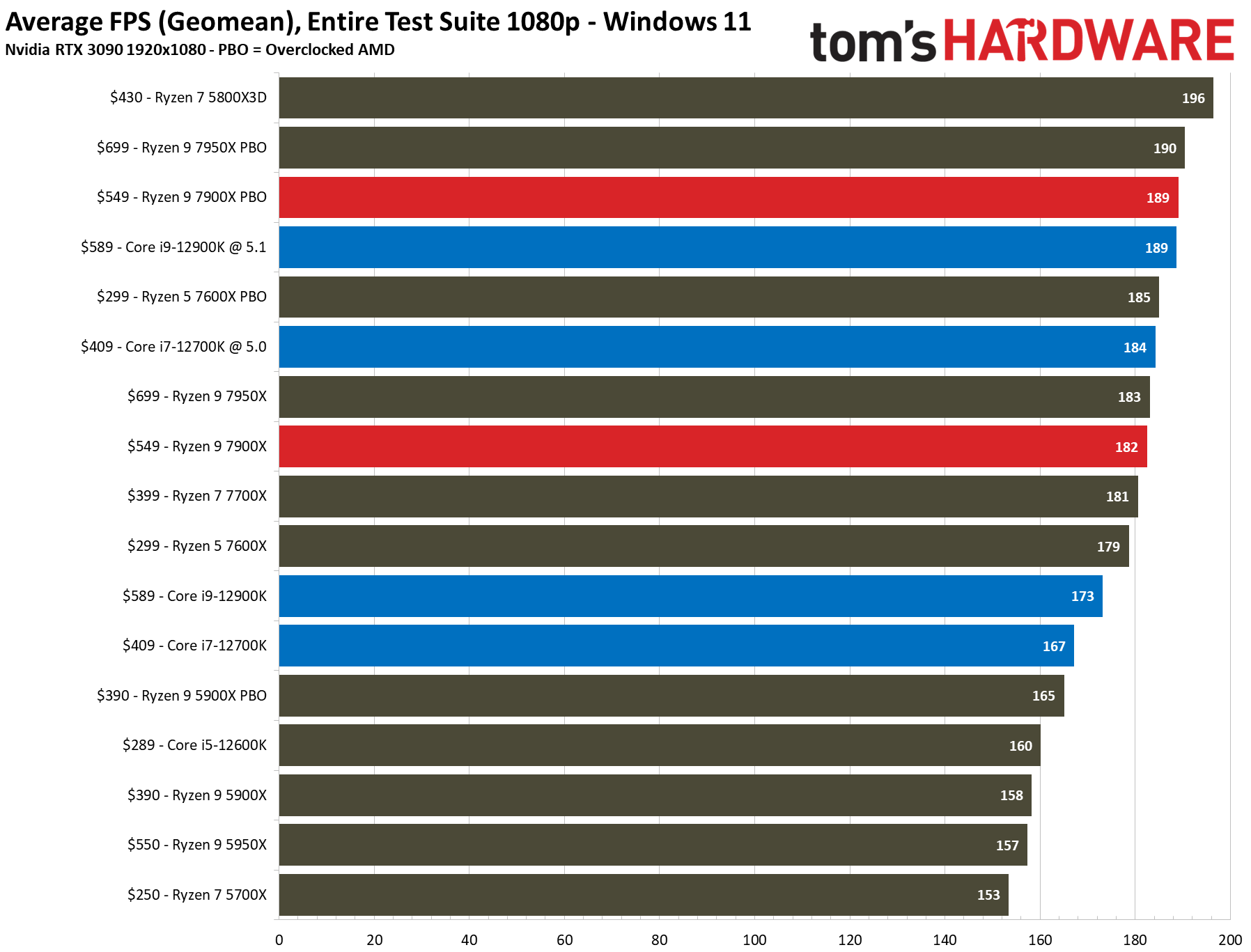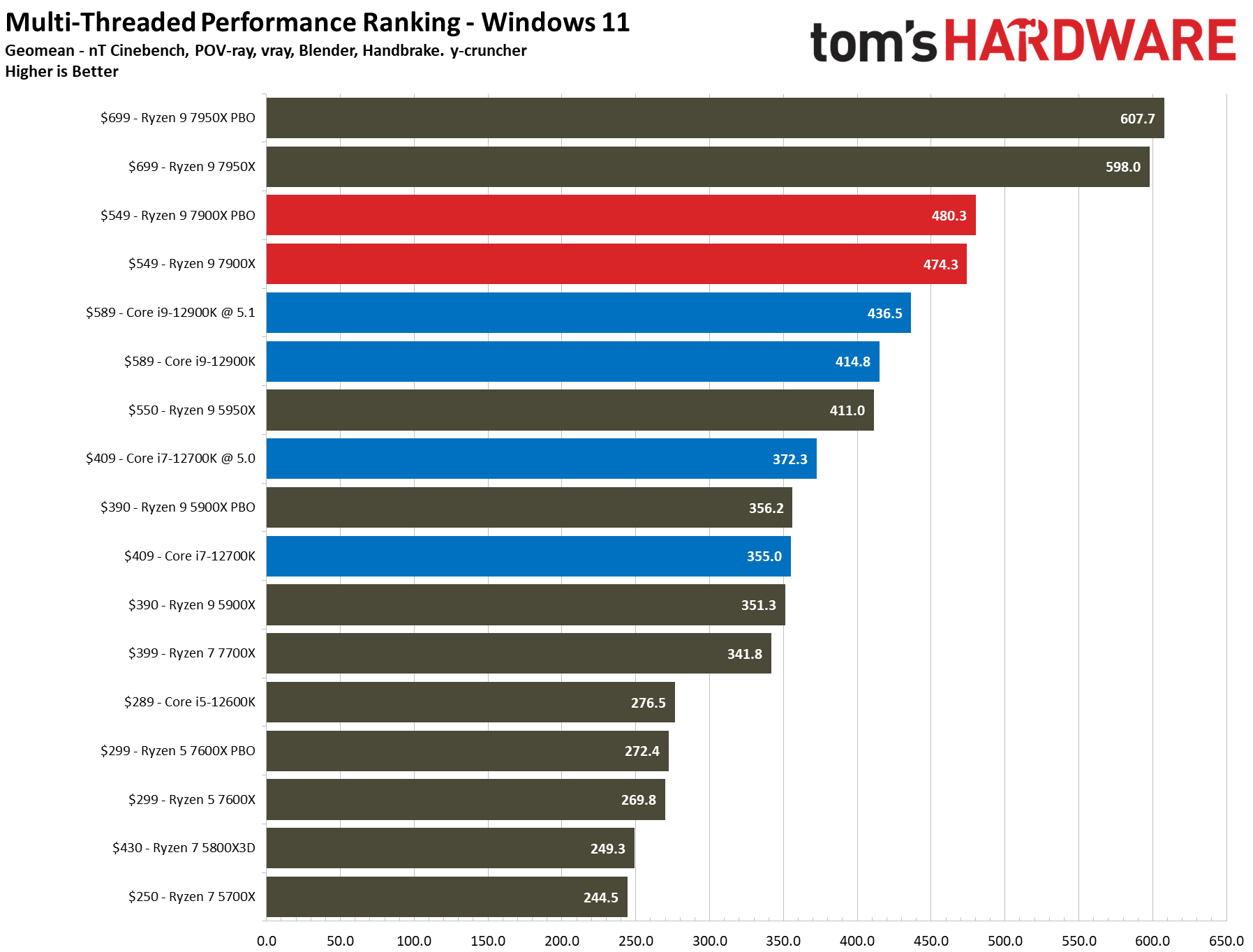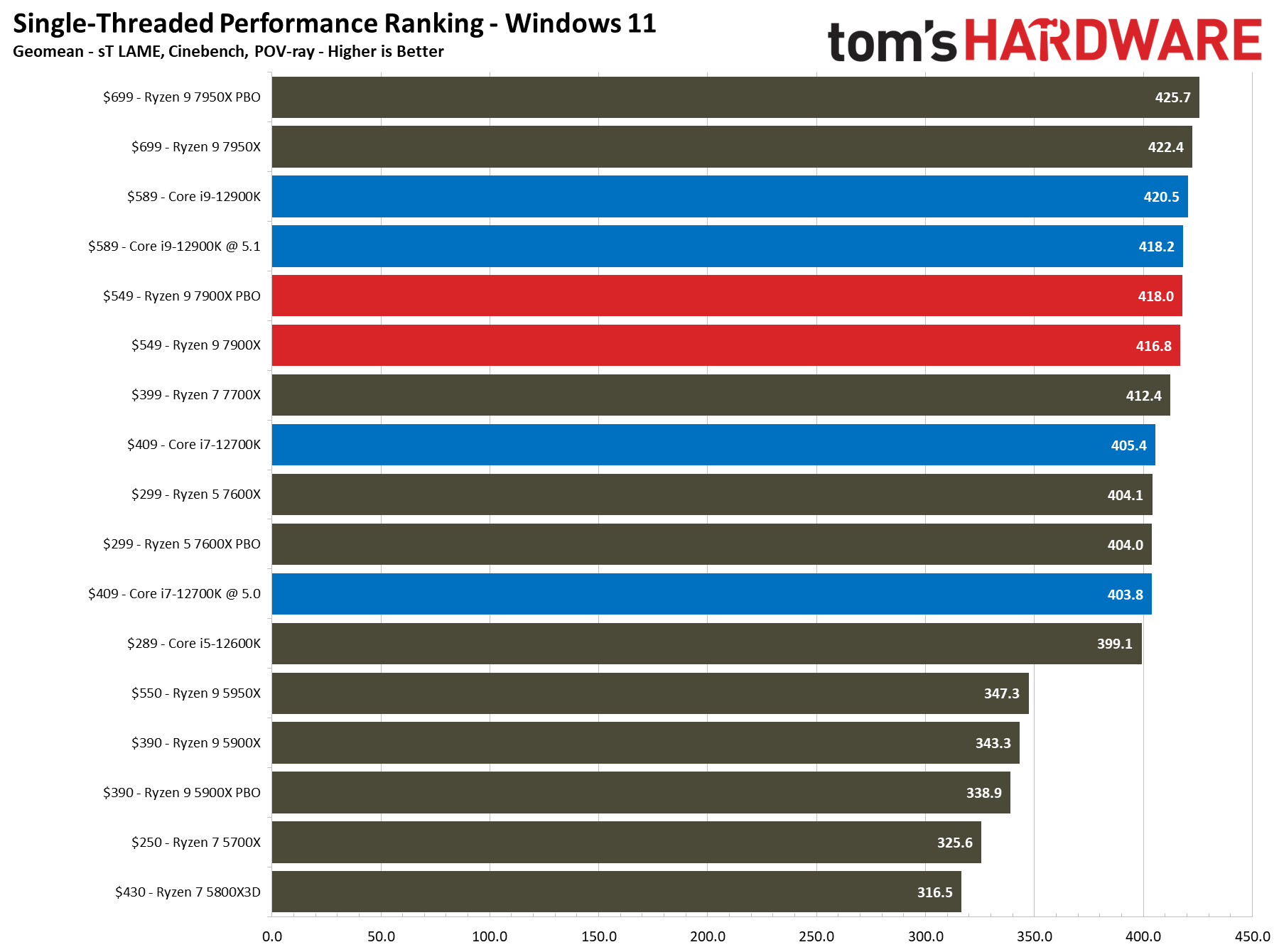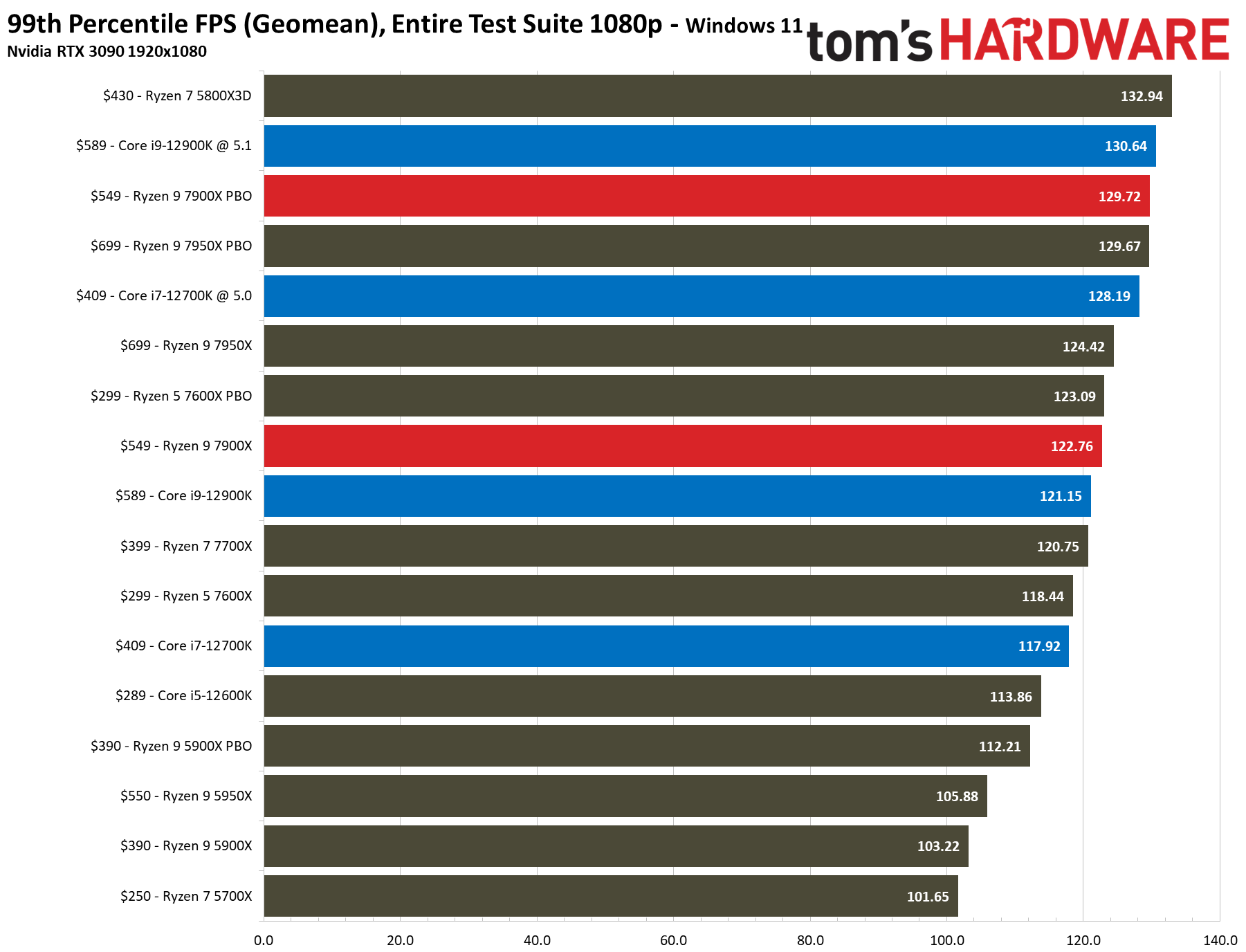Why you can trust Tom's Hardware
AMD’s Ryzen 9 7900X delivers impressive performance gains that beat Alder Lake in most types of workloads, including gaming. However, the chip, motherboard, and memory pricing conspire to reduce its appeal against Alder Lake, and we expect that disparity to become far more pronounced when Raptor Lake arrives later this month.
Below, we have the geometric mean of our gaming test suite at 1080p and 1440p and a cumulative measure of performance in single- and multi-threaded applications. We conducted our gaming tests with an RTX 3090, so performance deltas will shrink with lesser cards and higher resolution and fidelity settings — and might grow if you're using a future next-gen RX 7900 XT or RTX 4090.






If the Ryzen 9 7900X were a chip designed specifically for gaming, it would be a wonderful option with its Core i9-12900K-beating performance. However, as we see with most higher-tier chips, the 7900X's $549 price tag removes this chip from the picture if you're only interested in gaming — the $299 Ryzen 5 7600X and $399 Ryzen 7 7700X both offer nearly identical gaming performance.
The Ryzen 9 7900X is designed for the productivity-minded, and here its raw performance metrics shine. The 7900X was 14% faster than the $589 Core i9-12900K in our multi-threaded tests, but for $50 less. The Zen 4 architecture also closes the gap with Alder Lake in single-threaded applications, addressing a particularly glaring deficiency.
But the raw performance and the chips' price tag aren't the only factors in your build. AMD’s 600-series motherboards offer modern connectivity options, like DDR5 and PCIe 5.0, and also bring other additives, like USB4. However, they're significantly more expensive than comparable DDR5 motherboards for Intel systems, which we chalk up to the dual-chipset design. However, the B-series motherboards also don't appear as price-competitive with Intel's comparables, which is an inexplicable bummer.
And that's before we factor in the impact of AMD's decision to only support DDR5 memory with Ryzen 7000. Intel also has DDR4 motherboards available that are even cheaper, magnifying the price disparities between the two platforms.
DDR5 memory is also simply more expensive than DDR4. AMD’s decision to fully commit to DDR5 could be a liability if pricing remains higher than DDR4, but memory pricing is volatile, so this could change (you should check current pricing). AMD expects DDR5 pricing to improve as we enter the last part of the year, but this market can be unpredictable.
Get Tom's Hardware's best news and in-depth reviews, straight to your inbox.
We think the thermal 'issues' with AMD's Ryzen 7000, while not ideal in a perfect world, are a bit overblown. The Ryzen 7000 chips consume more power than their predecessors, but that is by design. AMD has improved its power delivery and uses that to turn the thermal headroom into extra performance that cuts through work quicker. Intel’s high-end chips are also designed to run at higher levels of power consumption, and thus heat, so this tactic isn't unheard of. In fact, AMD's prior-gen flagships also ran at similar temperatures with stock coolers.
AMD'S ECO Mode feature will reduce power consumption and thermals for those interested in a cooler and quieter system, but it does reduce performance. It also boosts efficiency. In that vein, AMD didn't make any efficiency strides with its flagship Ryzen 9 7950X because it sacrificed potential extra efficiency in the name of increased performance. This isn't entirely unexpected as companies dial up to the upper end of the voltage/frequency curve — the last few percentage points of performance often come at the expense of double-digit percentage increases in power consumption. However, the lower-tier models, like the Ryzen 9 7900X, offer better power efficiency than their prior-gen counterparts in the tests we've conducted.
AMD's biggest problem comes in the form of pricing, and that's before we account for the looming Raptor Lake launch on October 20. Intel has made confident performance claims of a 15% improvement in single-threaded, 41% improvement in threaded, and a 40% ‘overall’ performance gain, which means that Raptor Lake and Ryzen 7000 will be closely matched.
Given AMD's pricing challenges surrounding its AM5 motherboard ecosystem and DDR5 memory, not to mention Intel's aggressive Alder and Raptor Lake pricing, the Ryzen 9 7900X will need a meaningful price reduction to be competitive with other modern offerings.
- MORE: AMD vs Intel
- MORE: Zen 4 Ryzen 7000 All We Know
- MORE: Raptor Lake All We Know

Paul Alcorn is the Editor-in-Chief for Tom's Hardware US. He also writes news and reviews on CPUs, storage, and enterprise hardware.
-
chalabam The charts are hard to read. The fonts are too small, and the lines and dashes are very difficult to tell apart.Reply -
ddcservices Yet more nonsense in a supposedly unbiased review. Motherboards aren't really all that much more expensive than what came out for previous generations, outside of the boards that have far too many features or just add things that will cost a lot. PCI Express 5.0 support for example...a single PCIe 5.0 M.2 slot would be normal, and you will get it from all of the AM5 motherboards. Add a x16 slot with PCIe 5.0, and that adds to the prices.Reply
So, beyond this, boards like the Asus x670e Hero for $700...three M.2 slots with PCIe 5.0 speeds, the number of ports, this and that...yep, excessive, but the number of PCIe 5.0 slots are going to do that, along with Asus just charging a lot. The ASRock boards are NOT overpriced, and many of the other motherboards aren't overpriced really. So, no reason to complain about prices.
DDR5...$70 more than good DDR4 memory, compare the price of DDR4-3600 to DDR5-6000, yea, a bit of a price premium for DDR5, but it's new, and DDR5 prices are NOT really horrible. So, "pricing problem" seems to be more about an Intel bias, because other than, "it's new and hasn't been discounted". The pure gaming performance people will be happy with older AM4 for this generation and the Ryzen 7 5800X3D, but for those who do more than play games, honestly, motherboard+CPU+RAM all at the same time, CPU prices are NOT at a premium compared to previous generations, motherboards are generally at a comparable price, outside of a lack of cheap/low end boards that have no features, and B650 will cover that for the most part. RAM, don't compare DDR4-3000 to DDR5-6000 for price, because that's not a fair comparison. As I said, G.skill Trident Z5 Neo 6000CL30 vs. DDR4-3600CL14, what's the real price difference? Not really enough to complain about.
I may be biased, but not pointing out how Intel boards with similar features and on DDR5(not the cheaper DDR4 versions) are only cheaper because Intel is willing to give away chipsets at this point. -
TechieTwo According to reviews from those building AM5 systems the performance and value is fine from those not buying the extortion model mobos.Reply -
PlaneInTheSky ReplyYet more nonsense in a supposedly unbiased review. Motherboards aren't really all that much more expensive than what came out for previous generations
uhm, yes they are
The motherboards are a lot more expensive in nominal terms. Add in the depreciation of many currencies, and these AMD motherboards are extremely expensive. Add in the cost of DDR5.
The result is an outrageously expensive Zen 4 platform that doesn't even perform that well in games.
Zen 4 is going to need a massive price cut when Raptor lake arrives in a few days. Price / performance, Zen 4 is a disaster. The review is spot on. -
PlaneInTheSky ReplyDDR5 prices are NOT really horrible
Yes they are. Regardless, you have to buy new memory. It's not just about how much more DDR5 costs compared to DDR4, it's about needing to throw away DDR4 because AMD had the bright idea that dropping DDR4 compatbility was a smart move. This foolish decision is going to cost them a lot in sales. -
fybyfyby Reply
I agree with some of your statements. I bought new platform and it was worth it. But if I compare prices, DDR5 6000 EXPO costs nearly double the DDR4. Motherboard - ASUS B650 - E costs 9500 CZK and AM4 version (B550 - E) cost me 6500 CZK - but I didnt buy it at the start of the chipset. It was during the chipset lifetime. anyway, its more expensive. It may be due to PCIex5 added cost, I dont know. Also, DDR5 are new. Every gen, new DDR memories are "expensive".ddcservices said:Yet more nonsense in a supposedly unbiased review. Motherboards aren't really all that much more expensive than what came out for previous generations, outside of the boards that have far too many features or just add things that will cost a lot. PCI Express 5.0 support for example...a single PCIe 5.0 M.2 slot would be normal, and you will get it from all of the AM5 motherboards. Add a x16 slot with PCIe 5.0, and that adds to the prices.
So, beyond this, boards like the Asus x670e Hero for $700...three M.2 slots with PCIe 5.0 speeds, the number of ports, this and that...yep, excessive, but the number of PCIe 5.0 slots are going to do that, along with Asus just charging a lot. The ASRock boards are NOT overpriced, and many of the other motherboards aren't overpriced really. So, no reason to complain about prices.
DDR5...$70 more than good DDR4 memory, compare the price of DDR4-3600 to DDR5-6000, yea, a bit of a price premium for DDR5, but it's new, and DDR5 prices are NOT really horrible. So, "pricing problem" seems to be more about an Intel bias, because other than, "it's new and hasn't been discounted". The pure gaming performance people will be happy with older AM4 for this generation and the Ryzen 7 5800X3D, but for those who do more than play games, honestly, motherboard+CPU+RAM all at the same time, CPU prices are NOT at a premium compared to previous generations, motherboards are generally at a comparable price, outside of a lack of cheap/low end boards that have no features, and B650 will cover that for the most part. RAM, don't compare DDR4-3000 to DDR5-6000 for price, because that's not a fair comparison. As I said, G.skill Trident Z5 Neo 6000CL30 vs. DDR4-3600CL14, what's the real price difference? Not really enough to complain about.
I may be biased, but not pointing out how Intel boards with similar features and on DDR5(not the cheaper DDR4 versions) are only cheaper because Intel is willing to give away chipsets at this point.
So nothing to whine about. CPUs are great and if for someone AM5 is expensive, he or she can buy AM4 and it will last several years without a problem. -
somebassplayer The "pricing problem" is early adopter tax. People who want to be the first on their block to get onto 7xxxx series should expect to pay high(er) prices. The rest of us will wait until prices come down beforeReply
upgrading. -
ikernelpro4 Reply
I don't know about you but AM4 compatibility would've been clever to at least get more people / "early adopters".somebassplayer said:The "pricing problem" is early adopter tax. People who want to be the first on their block to get onto 7xxxx series should expect to pay high(er) prices. The rest of us will wait until prices come down before
upgrading.
100%. A lot of folks bought fast, perhaps even premium, DDR4 RAM in the past year or two, especially during the crazy-price pandemic.PlaneInTheSky said:Yes they are. Regardless, you have to buy new memory. It's not just about how much more DDR5 costs compared to DDR4, it's about needing to throw away DDR4 because AMD had the bright idea that dropping DDR4 compatbility was a smart move. This foolish decision is going to cost them a lot in sales.
I bought DDR4 3200 RAM and I do not plan to upgrade any time soon regardless what chip manufacturers present.
AMD simply bet on the wrong horse.
This is not a new platform that people who want to build complete new systems will fall onto, the price is not allowing that.
DDR5 is fast but you know what's also BLAZING fast? DDR4. Especially +3200 MHz. This is not a noticeble, jump like you PC unfreezes or suddenly memory intensive operations run like a night-day difference.
We have reached a point where "old" aka current hardware is so fast, that even many(!) years from now, they'll be fast and viable enough to substain.
This is not a jump from 5MB of DDR2 RAM to 16GB DDR4, this isn't a completely new platform. There's no incentive. -
Pyrostemplar ReplyPlaneInTheSky said:uhm, yes they are
The motherboards are a lot more expensive in nominal terms. Add in the depreciation of many currencies, and these AMD motherboards are extremely expensive. Add in the cost of DDR5.
The result is an outrageously expensive Zen 4 platform that doesn't even perform that well in games.
Zen 4 is going to need a massive price cut when Raptor lake arrives in a few days. Price / performance, Zen 4 is a disaster. The review is spot on.
No, it is a rather poor review, as it bases most (if not all) of its conclusion on the price of other components. In itself it wouldn't unreasonable if there was anything structurally definitive about the price of those said components: e.g. 4 channel server class motherboards. But no, AM5 mobos and DDR5 are the mainstream solutions going forward, so this review - and its conclusion - will age really badly.
AM5 X670E motherboards are already available under 300USD, and DDR5 is dropping price by the day. They won't go under DDR4 solutions pricing, but with inflation as it is, that is not really surprising, is it?
Zen 4 itself doesn't need a price cut unless Raptor outperforms its price/performance. If it does, then price cuts will be forthcoming - all the better for me :) -
cirdecus This is really not a good review. You don't knock off two stars for a product that is an excellent performer, priced well and uses the latest platform and technology. If you're upset that DD5 and AM5 costs a lot of money, that's a completely different article.Reply
Also, every new technology has come with a cost premium. Right now, you're intersecting a new socket, with new RAM technology and new PCI 5.0 tech all into one upgrade cycle. I don't care whether you go with an Intel platform or AMD platform, you're paying a lot for DD5, regardless. If you downgrade to DDR4, great, you can go with intel.
Complaining that DDR 5200 (6000 is actually what AMD recommends) is only supported by one channel and filling out the banks with 4 sticks drops the speed, is a relatively decent complaint. However, it's half a star at best. You're not going to win an argument that people need more than 64GB of highspeed memory in a system like this. If you need more, then this isn't the right platform. Users should be steered towards AMD's HEDT Thread-rippers. Mainstream processors simply don't need more than 64GB of memory. That's the equivalent of knocking an automobile manufacturer for not offering a 15000lbs towing capacity for their mid-sized trucks.